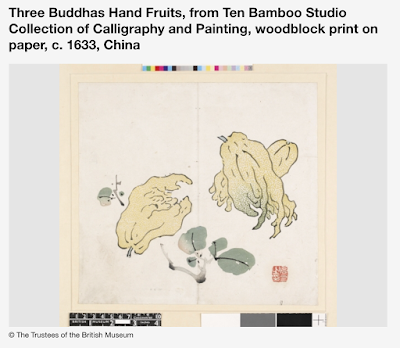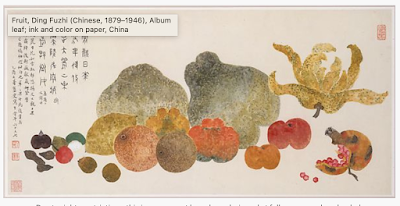I am still reading "Handbook of Korean Art, Folk Paintings" by Yeolsu Yoon, translated by Wonjun Nam
and Yoon says that the image of Buddha's hand, the pulsugam, means plentiful offspring, long life and bountiful happiness. pg 17
In the glossary at the back of the book he says that pulsugam (Buddha's hand cirtrus) is a symbol wealth.
I don't know what Buddha's hand citrus means so I looked up some images on Google. I don't think I've ever seen this fruit. Not even in the fancy grocery stores.
And I kind of wondered how this fruit is depicted in art. So I looked that up as well. I am taking these notes during January 2021 and while we are not in "lock down" due to COVID, libraries and museums are not easily accessible to me in Nelson County VA so I'm doing my best via Google. And frankly, that isn't too bad. Imagine 30 years ago, pre Google, pre public internet...
I found this image via the British Museum Images: https://www.bmimages.com/preview.asp?image=00711851001
The image is a Chinese woodblock print from 1633 by Gao You. The image is for sale. I'm going to go ahead and screen shot it here unless suddenly I have a lot of visitors and then I will take it down.
I just spent several minutes on the Metropolitan Museum of Art's webpage. Searching on "Korea" brought back zero results. Searching on "China" brought back over nineteen thousand but if I narrow the search I can find some examples.
So this one, which is from 1945 and laid out in a very typical, western, sort of way. I don't know if this is representative of Chinese paintings at the time and whether or not it represents western influence.
This piece is listed as 18th century China. description "
The Buddha’s-hand citron takes its common name from the shape of its fruit, which resembles the idealized fingers of the Buddha. Although the fruit is not edible, it has a strong fragrance and is used as an offering at the altar. Its name in Chinese, foshou, has almost the same sound as the words for “fortune” (fo) and “longevity” (shou), adding another layer of good wishes." https://www.metmuseum.org/art/collection/search/44147
and finally at the Smithsonian. I am super excited about this piece, this is what I was looking for.
It is titled "Bird, Fruit and Flowers" and from the Smithsonian website I cannot tell to what artist, country or time it is attributed. It is lovely. There are four images total that appear under "citron" in the Smithsonian Freer Gallery of Art and Arthur M. Sackler Gallery.
https://asia.si.edu/subject/citron/
I would love to find more examples of Buddha' hand citron in Korean art work. Please, if you know any, leave a comment and maybe a link?








Comments
Post a Comment